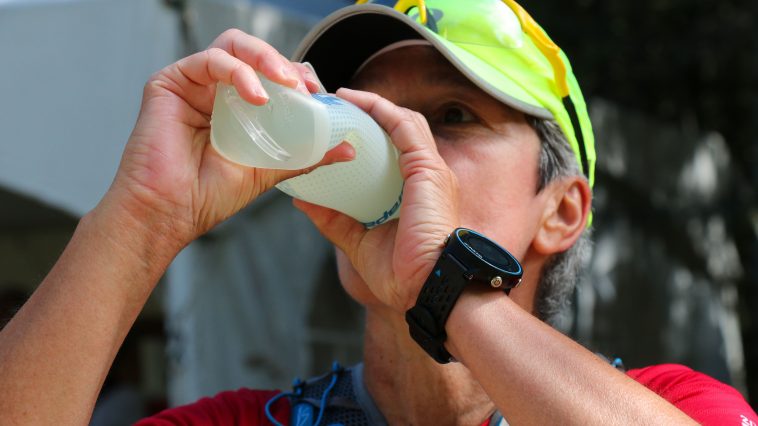As an athlete I have received a lot of advice on this subject:
« Drink before you are thirsty, »
« Thirst is a sign of dehydration. »
« Weight loss during exercise, however small, is a sign of dehydration and may result in reduced physical performance. It is important to drink so that you do not lose more than 2% of your initial body weight. »
« You have to drink a small amount of fluids every 15 minutes during your run. »
I also heard those advice in my professional development. Very often, those are the traditional recommendations that come to mind when we think about managing our hydration during a running event.
However, be aware that this advice, followed to the letter, can cause more harm than good, especially when racing very long ultras.

Hyponatremia: when drinking too much becomes dangerous
While severe dehydration can greatly affect an athlete and their performance, hyponatremia can have equally daunting consequences. However, this condition is much less known by athletes since the symptoms appear to be those of dehydration.
Hyponatremia occurs when the blood sodium concentration drops below normal values, or when it is too diluted. Typical symptoms then include decreased physical performance, a bloated feeling, nausea and vomiting, headache, and altered level of consciousness.
Who is at risk?
It is common to think that this phenomenon occurs mainly when our sodium intake is insufficient or that sodium loss is too great. However, it is not!
In fact, the main cause of the development of sports-related hyponatremia is rather overhydration. Drinking more fluid than the body can drain leads to a dilution of electrolytes in the blood, especially sodium.
If you gain weight during a race or in a long distance event, this is a signal that you have taken in too much hydration. It is essential to review your hydration strategy. During an ultra it’s completely normal to lose about 4% of your initial body weight.
What to do
You might think that the solution to hyponatremia is to consume sodium-containing drinks and supplements. However, be aware that the various sports drinks currently offered on the market are hypotonic, meaning their sodium concentration is lower than that of the body. Consumed in large quantities, these drinks will also have the effect of diluting your body’s reserves of electrolytes.
Electrolyte supplements (such as salt capsules) should be used in moderation. Although they provide a large amount of sodium, such a spike in sodium intake is likely to alter your regular need to quench your thirst, causing you to drink much more than your body would normally dictate. And as an aside, for some runners the risk of digestive disorders increases considerably with the intake of these products.
So what is the number one recommendation to prevent hyponatremia AND avoid severe dehydration?
Simply drink according to your thirst! Listen to your body: it is the best guide. Even when trying to calculate everything, the margin of error remains large. We have to remember that our dehydration will vary from day to day, depending on the weather conditions and the intensity of our effort. Your thirst will simply adjust to suit your needs. There is no need to force yourself to drink beyond your body’s physiological signal to slake its thirst.
Translation: Caroline Beaton
Isabelle Morin is a dietitian-nutritionist and has completed her diploma in sports nutrition with the International Olympic Committee. She is a lecturer at the University of Quebec in Trois-Rivières and collaborates with La Clinique du Coureur. You can meet with her in the Quebec City area or reach her via the internet. Visit her Facebook page.
Must read:
- How Your Gut Microbiota Will Make You a Better Runner
- Beware, alcohol affects fitness!
- What and How to Eat the Four Days Before a Big Race


